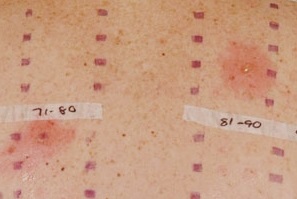Patient Information
Appointments
Most patients have to attend 3 appointments over a 5 day period.
Appointment 1 (Monday morning): Patients will have a consultation with the specialist dermatologist, who will decide what needs to be tested. The clinic nurse will then make the patches up and stick them on to the patient’s back. This appointment may take up to 2 hours.
Appointment 2 (Wednesday morning): The patches are removed and the patient will then wait at least 15 minutes before their back is looked at to see if there have been any allergic reactions or ‘red spots’ showing up where the patches were. This appointment may take up to 1 ½ hours.
Appointment 3 (Friday morning): The dermatologist will again look at the patient’s back to see if there has been any other ‘red spots’ show up where the patches were. The dermatologist will then discuss results, management of your condition and skincare. You will need to allow 1 ½ hours for this appointment.
How many patches?
The number of patches applied is specific to each individual. There are 10 discs on each patch and those attending our clinic often have approximately 7-10 patches or sometimes more placed on their back.
Why my back?
The back is used for patch testing because it has lots of room to put the patches on. This also gives people the opportunity to have a bath, as the patches must be kept dry during the testing. Showers must be avoided for the length of the testing (Monday through to Friday after final appointment).
Preparation for testing
Shower the morning of the tests, as you cannot get your back wet from the time the patches go on until the time you see the dermatologist for your third appointment.
During testing, sweating must be avoided, as sweating can sometimes cause patches to fall off or loosen. So if you are working in a job where you get hot and sweaty, please call us for advice. Physical activity or playing sports during testing is also strongly discouraged.
Do not get your back exposed to sunlight for 5 days prior to testing. It is suggested that sunlight before testing may reduce the immune response in the skin, and so the tests may not work properly.
Do not put any creams or oils on your back the morning of the testing.
If your doctor has given you cortisone or prednisolone tablets for your skin condition please call us for advice. Generally prednisolone/cortisone tablets should not be taken 48 hours before testing.
Men with hair on their backs should shave or wax it off a day or two before testing (do not use chemical hair removal products).
What does an allergic reaction look like?
Once the patches are taken off, the dermatologist looks for any red raised spots that may have appeared. These are normally smaller than a 5 cent coin and appear where the discs were placed. Sometimes people find these to be itchy.

What if the patch testing is negative?
If this testing is negative, it may suggest that you have a different skin condition such as irritant contact dermatitis, eczema or contact urticaria (other forms of testing known as prick testing or a blood test is used to diagnose contact urticaria).
How much will patch testing cost?
The cost of the consultations and patch testing is usually between $650-$750, approximately half of which can be claimed back from Medicare (or the full amount by WorkCover if appropriate).
WorkCover Claims: please bring claim details. If your skin condition is considered to be work-related an account can be sent to your employer. Please bring your employers mailing address details with you.
Healthcare cardholders: upon presentation of Healthcare and Medicare cards, patients will be charged a reduced fee (and approximately 65% of the cost can be claimed back on Medicare).
Pension cardholders: upon presentation of pension and Medicare cards, pension card holders will be charged a further reduced fee (and approximately 85% of the cost can be claimed back from Medicare).
When do I pay?
Payment in full is required at your final appointment.
Instruction for patients during testing (when the patches are on)
Care of your patches
1. Do not get your back wet. Have a shallow bath or wash from hand basin.
2. Do not do any physical activity that will make you hot and sweaty. The sweat will lift the patches off from underneath, and the tests may not work properly.
3. Do not scratch your back while the patches are on or for several days after they have been removed. Scratching can cause false results or make it impossible to
read your reactions accurately.
4. Get someone to press the patches down with a flat hand from time to time during the day, especially in the morning when you get out of bed. If the patches start to lift, get that person to stick them back down for you. We use Micropore tape, which is hypoallergenic and can be purchased from your local chemist.
5. If your back gets itchy or uncomfortable, lean against something cold such as the outside of a fridge door. The cold metal soothes the back.
6. If your back becomes unbearable contact your Doctor.
